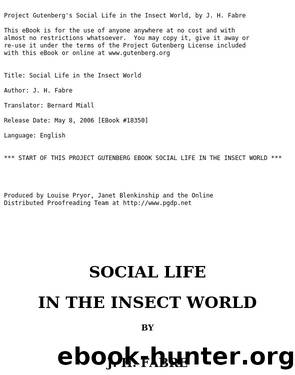Social Life in the Insect World by Jean-Henri Fabre

Author:Jean-Henri Fabre [Fabre, Jean-Henri]
Language: eng
Format: epub
Tags: Insect societies, Insects -- Behavior
Published: 2006-05-07T16:00:00+00:00
Here is a partial explanation of the double system of the Hymenoptera with their carnivorous larvæâthe system of dead or paralysed insects followed by honey. But here the point of interrogation, already encountered elsewhere, erects itself once again. Why is the larva of the Osmia, which thrives upon albumen, actually fed upon honey during its early life? Why is a vegetable diet the rule in the hives of bees from the very commencement, when the other members of the same series live upon animal food?
If I were a "transformist" how I should delight in this question! Yes, I should say: yes, by the fact of its germ every animal is originally carnivorous. The insect in particular makes a beginning with albuminoid materials. Many larvæ adhere to the alimentation present in the egg, as do many adult insects also. But the struggle to fill the belly, which is actually the struggle for life, demands something better than the precarious chances of the chase. Man, at first an eager hunter of game, collected flocks and became a shepherd in order to profit by his possessions in time of dearth. Further progress inspired him to till the earth and sow; a method which assured him of a certain living. Evolution from the defective to the mediocre, and from the mediocre to the abundant, has led to the resources of agriculture.
The lower animals have preceded us on the way of progress. The ancestors of the Philanthus, in the remote ages of the lacustrian tertiary formations, lived by capturing prey in both phasesâboth as larvæ and as adults; they hunted for their own benefit as well as for the family. They did not confine themselves to emptying the stomach of the bee, as do their descendants to-day; they devoured the victim entire. From beginning to end they remained carnivorous. Later there were fortunate innovators, whose race supplanted the more conservative element, who discovered an inexhaustible source of nourishment, to be obtained without painful search or dangerous conflict: the saccharine exudation of the flowers. The wasteful system of living upon prey, by no means favourable to large populations, has been preserved for the feeble larvæ; but the vigorous adult has abandoned it for an easier and more prosperous existence. Thus the Philanthus of our own days was gradually developed; thus was formed the double system of nourishment practised by the various predatory insects which we know.
The bee has done still better; from the moment of leaving the egg it dispenses completely with chance-won aliments. It has invented honey, the food of its larvæ. Renouncing the chase for ever, and becoming exclusively agricultural, this insect has acquired a degree of moral and physical prosperity that the predatory species are far from sharing. Hence the flourishing colonies of the Anthophoræ, the Osmiæ, the Euceræ, the Halicti, and other makers of honey, while the hunters of prey work in isolation; hence the societies in which the bee displays its admirable talents, the supreme expression of instinct.
This is what I should say if I were a "transformist.
Download
This site does not store any files on its server. We only index and link to content provided by other sites. Please contact the content providers to delete copyright contents if any and email us, we'll remove relevant links or contents immediately.
The Light of Days by Judy Batalion(833)
The Crime Book by DK(707)
Chasing the Thrill by Daniel Barbarisi(660)
1312, Among the Ultras by James Montague(588)
The Doctor Who Fooled the World by Brian Deer(567)
E.R. Nurses by James Patterson(564)
Till Murder Do Us Part by James Patterson(561)
Invention by James Dyson(561)
The Complete Correspondence 1928-1940 by Theodor W. Adorno & Walter Benjamin(508)
Climb by Susan Spann(492)
Mind Games by Neville Southall(481)
The Reporter by Mark Paul Smith(480)
Space 2069 by David Whitehouse(479)
The Dream Architects by David Polfeldt(478)
Surely you Ìre joking, Mr Feynman by Richard Feynman(462)
If You Should Fail by Joe Moran(446)
Masterful Marks: Cartoonists Who Changed the World by Monte Beauchamp(432)
The 'Wolfman' by Sigmund Freud & Sigmund Freud(430)
Banking and Beyond by Unknown(424)
